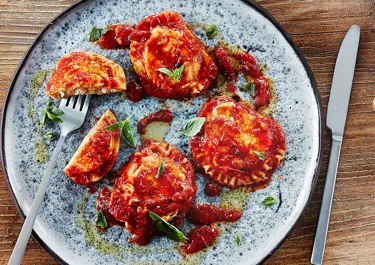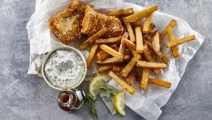Potato ravioli

Experience a delicious twist on a classic with our potato ravioli, where Polish pierogi meets Italian ravioli. We have taken the traditional potato filling, enriched it with crumbled white cheese, and encased it in smooth ravioli dough. Served with a rich tomato sauce, this dish blends the best of two culinary worlds, making it a perfect choice for a standout meal that is easy to prepare and sure to impress.
Ingredients
Pasta dough
|
Flour
|
400 g |
|---|---|
|
Eggs
|
4 |
|
Semolina or durum wheat for rolling the pasta
|
Filling
|
Baking potatoes, peeled and diced
|
500 g |
|---|---|
|
Onion, peeled and finely chopped
|
1 |
|
Olive oil
|
3 tbsp |
| 200 g | |
|
Salt and pepper to taste
|
|
|
A pinch of ground nutmeg
|
|
|
Fresh basil leaves, chopped (optional)
|
Tomato sauce
|
Chopped tomatoes (400 g)
|
1 can |
|---|---|
|
Garlic clove, minced
|
1 |
|
Olive oil
|
50 ml |
|
Chilli flakes
|
½ tsp |
|
Dried oregano
|
1 tbsp |
|
A pinch of sugar
|
|
|
Fresh basil (optional)
|
Instructions
Pasta dough
Filling
Tomato sauce
Assembling
FAQ: Questions about potato ravioli
We have answered some common questions about potato ravioli to make it as easy as possible for you to start cooking.
How long should I cook the ravioli?
For perfectly cooked potato ravioli, boil them in a large pot of salted water. Depending on the thickness of the pasta, cooking usually takes 3–4 minutes. Watch for the ravioli to float, which means they are al dente. Taste one to ensure it is cooked through with a firm bite. If you make a big batch, cook in smaller amounts for 4 minutes after the water boils again. Avoid overcooking to prevent them from becoming mushy. Thicker pasta might need 5–6 minutes. Frozen ravioli will need 1–2 minutes longer. Gently strain them after boiling to keep their shape intact.
What is the difference between ravioli and pierogi?
The main differences between the two are the dough and the filling. Ravioli come from Italy and feature an egg-based pasta dough with semolina flour, filled with a mix of ingredients such as cheese, meat, vegetables, or seafood, usually served with a sauce. Pierogi are Eastern European, particularly Polish, made with a simple dough with all-purpose flour and sour cream, filled with options like mashed potatoes, cheese, sauerkraut, mushrooms, or meat. They are boiled, sometimes fried, and often topped with onions, sour cream, or bacon bits.
Tips: Learn how to make the best potato ravioli
Discover the secrets to perfecting our potato ravioli, from dough to delightful dish. Impress your guests with a meal that is as enjoyable to make as it is to savour.
Pasta dough kneading
Kneading pasta dough is essential for perfect potato ravioli – you can do this by hand or with a mixer. Work the dough for 10 minutes until smooth and elastic. This is crucial for developing the gluten, which gives the pasta structure and texture. The dough is ready when it forms a ball and stops sticking to your hands. Once kneaded, wrap the dough in cling film and let it rest for about 1 hour. This allows the gluten to relax, making the dough easier to roll out.
Roll out your pasta dough without a pasta machine
If you do not have a pasta machine, it does not deter you from making delicious potato ravioli. With a rolling pin and careful attention, you can roll out the dough to the perfect 2 mm thickness. For optimal results, employ a wooden chopping board as your rolling surface to achieve an even texture. Take your time to reach a uniform thickness, and you will make ravioli that rival those made with a machine.
Master the seal
To ensure your potato ravioli maintain their shape and keep their tasty filling during cooking, seal them with care. Start by rolling the pasta dough until thin and almost see-through. Place small portions of potato filling, roughly the size of a walnut, onto the dough, leaving at least 6 cm between them. Dampen the dough around each filling with water to help the pasta layers stick together. Fold the dough over the filling and press from the centre outwards to remove air, which can make ravioli burst when boiled. Press the edges firmly to seal. For extra security, crimp the edges with a ravioli cutter or a fork. This gives your ravioli a classic look and keeps them sealed while cooking.
Keep fresh with proper storage
If you want to enjoy your homemade potato ravioli later, store them correctly to keep their flavour and texture. If you are going to eat them within a few days, place them on a semolina-dusted tray to stop them from sticking. Cover with cling film and store in the fridge. For longer storage, freeze them. Spread the ravioli on a tray, not touching each other, and freeze them until solid. Then, put them in a freezer bag. This way, your ravioli will stay fresh until you are ready to enjoy them.
Homemade potato ravioli with a twist
From our kitchen to yours, we share the secrets of making the perfect potato ravioli. We have chosen each ingredient carefully and infused every step of the recipe with love. The rich potato filling, wrapped in soft pasta, comes to life with each bite, especially when paired with our bold tomato sauce. It is a dish that promises to warm hearts and fill stomachs. We have even added a slight twist to the classic potato filling by introducing white cheese to the mix.
We have plenty more tasty recipes in store for you. How about trying our grilled salmon salad with crisp vegetables, roasted winter vegetables, or tomato tarte tatin? These recipes will guide you through each step and show you that scrumptious does not have to be complicated.
Potato filling with white cheese, onion, and nutmeg
We begin with golden-fried, diced baking potatoes and finely chopped onions that caramelise to a rich sweetness. This base sets the stage for the white cheese. Its creamy texture melts into the potatoes, providing a lush contrast to the earthy flavours. A pinch of ground nutmeg introduces warmth and a subtle spice, enhancing the natural flavours of the other ingredients. For those who enjoy a hint of freshness, optional chopped fresh basil adds a peppery zest. This filling not only captivates the palate but also turns each bite of our potato ravioli into a comforting, flavourful embrace.
Served with a rich tomato sauce
A sumptuous tomato sauce is the ideal partner for the robust filling of our potato ravioli. We make the sauce from canned tomatoes and let it simmer until it reaches the perfect thickness to coat the ravioli well. Garlic adds warmth, chilli flakes bring a subtle kick, while oregano brings an herby note that honours the Italian heritage. A little sugar counters the tartness of the tomatoes and rounds off the flavour. Whether for a simple family meal or a special event, this rich and creamy tomato sauce makes our potato ravioli a truly satisfying dish.
Polish pierogi meets Italian ravioli
In this recipe, homely Polish pierogi join forces with classic Italian ravioli. It is a nod to both the rustic potato filling of the pierogi and the delicate, smooth pasta of ravioli. This recipe crosses borders, uniting the best of both worlds and will likely become a treasured part of your recipe collection. It invites you to enjoy the rich, buttery flavours of Poland’s favourite comfort food with a hint of Italian refinement.
Experiment with the filling
Here is how you can play with the filling to create something that is truly yours. While white cheese is great in combination with the potatoes, you can also use ricotta for its smoothness, sharp cheddar for a bolder flavour, or smoked Gouda and blue cheese for added depth.
Also, try cooked, crumbled bacon, which offers a smoky touch, or minced chicken that adds heartiness. Small shrimp can make each ravioli a mini seafood treat.
Vegetables also make excellent additions. Spinach, mushrooms, or roasted red peppers not only add vibrant colours but also enhance the filling with their flavours and textures. Ensure these are cooked and finely chopped to blend seamlessly with the creamy potatoes.
Herbs and spices are the simplest way to diversify your filling. Consider thyme, rosemary, or sage for their aromatic properties, or introduce cumin or paprika for a hint of warmth and smoke.









